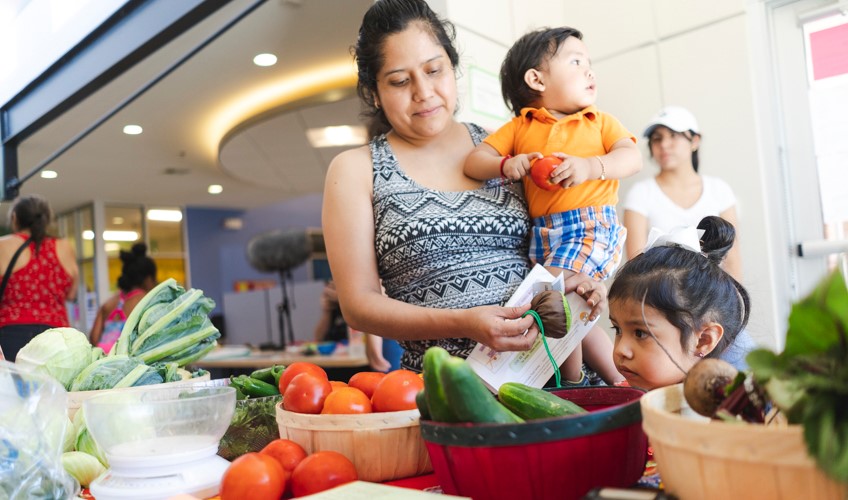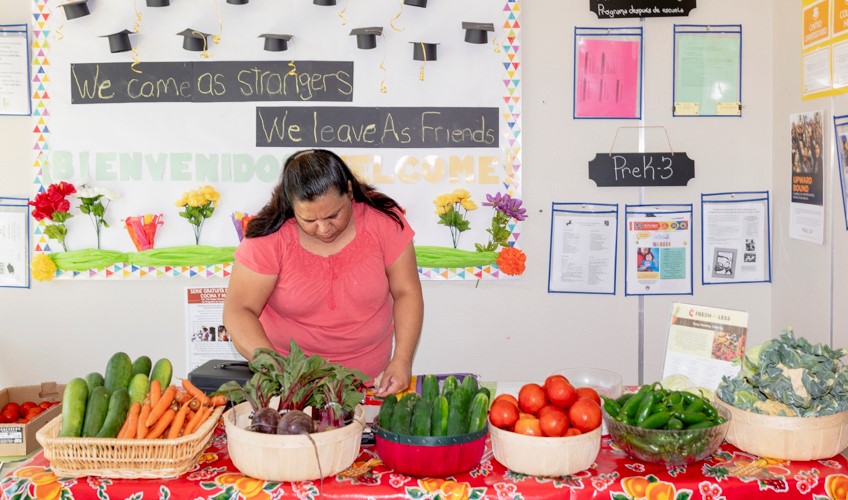Links to various Aetna Better Health and non-Aetna Better Health sites are provided for your convenience. Aetna Better Health is not responsible or liable for non-Aetna Better Health content accuracy or privacy practices of linked sites or for products or services described on these sites.
Creative ways Aetna is helping communities across the U.S. address food insecurity
 By Alice Gomstyn
By Alice Gomstyn

When her family faced lean times a few years ago, Frances helped make ends meet by skimping on grocery purchases. She says she and her children often subsisted on packets of instant soup. Frances knew it wasn’t a healthy choice, but she didn’t feel she had any alternatives.
“It’s a hard thing when somebody comes to you and tells you, ‘You need to eat healthy,’ and you’re not able to,” she says.
Frances’ experience is all too familiar for people across the country. According to the USDA , more than one in 10 families are food insecure. Many want to eat better but live in food deserts or food swamps. For others, it’s a matter of not knowing which foods could truly make a difference in their diets.
Fortunately, organizations across the country are tackling these types of challenges head on with creative approaches that provide residents with the food and education they need to live healthier lives. Aetna and the Aetna Foundation have partnered with these groups and offer financial support to fuel innovative solutions. Here are some examples:
Free food, full bellies
Sometimes, the most effective solution to food insecurity is the simplest: Offer free, nutritious food to people in need, no strings attached, and they will take it. In New Jersey, Aetna Better Health, Aetna's Medicaid managed care health plan, hosts monthly food giveaways at Aetna Healthcare Central, its Newark location. Newark is in New Jersey's Essex County, where nearly 1 and 5 people is considered food insecure.
Magdaliza Aviles, the store manager, and her staff hand out bags filled with fresh produce as well as rice and beans or spaghetti. The giveaway is open to anyone, not just Aetna members. "We typically have people lining up," Aviles says. "It's first come, first served. The first 400 people who show up, we give them a bag of food." Some community members were surprised by the giveaways at first, she says. "There was a woman who pulled up and said, 'Wait a minute, an insurance company is in my neighborhood giving food out to anyone?' She was so impressed."
For those who are both food-insecure and suffer from major health problems, free food delivery services can be a lifesaver. Researchers have found that well-nourished patients have fewer hospitalizations, and those who are hospitalized are less likely to be readmitted. In Pennsylvania, Aetna Better Health has partnered with MANNA, a food delivery service that specializes in bringing medically tailored meals to the chronically ill. People with diabetes, hypertension, cancer and other conditions receive meals specifically designed to meet their nutritional needs. Meal recipients also benefit from counseling from MANNA's registered dietitians, who offer advice on controlling glucose levels, understanding carbohydrate counts and other healthy strategies.
Meeting people where they are
When people do have money in their budgets to buy good food, access often remains a hurdle. Often, there just aren't stores in their neighborhoods that sell affordable, healthy options. That's why nonprofit organizations like GO! Austin/¡VAMOS! Austin (GAVA) are bringing fresh produce directly to underserved areas through partnerships with local community members and small businesses.
GAVA, which was supported by a $100,000 grant from the Aetna Foundation, works with the Sustainable Food Center, another Austin, TX-based nonprofit, to provide fresh produce to farm stands run by community members. Those community members include Lilia, who sells cucumbers, carrots, and other fresh produce at her weekly "Fresh For Less" stand based at a community center. The center is part of the low-income housing complex where Lilia lives, and she serves about a dozen of her neighbors a week.
Sales are on the rise at Lilia's stand and at other local stands, with customers now spending more per purchase. Simone Benz, a food access projects manager at SFC, says the convenient locations of the stands — including apartment building lobbies, school parking lots and recreation centers — are critical to their success. “Food access is really about meeting people where they are," she explains.

Lilia sets up the Fresh For Less farm stand. She serves a dozen or so customers each week.
GAVA's Healthy Corner Store initiative also aims to bring food within walking distance of low-income communities, this time focusing on local corner stores. It's a strategy that has the support of Frances, who joined the group as a paid community organizer in 2017. Frances said grocery stores are a 10-minute drive from her neighborhood, for those lucky enough to have a car. But for residents who rely on public transportation or are strapped for time, the corner store is often the only option.
To ensure healthy items are available there, Frances and other GAVA staff members met with store owners and urged them to stock better-for-you staples like bananas, avocados, potatoes and cheese. Though many were hesitant about investing in new inventory and expensive refrigerated storage units, Frances assured them that it would be worth it. And she was right. A five-year study of the area found that the percentage of people who bought fruits and vegetables from corner stores increased from 24% to 35% over four years. Residents also ate a greater variety of vegetables, consuming more than one cup of them daily, on average.
Teaching healthy habits early
Some nonprofit organizations focus on getting kids excited about healthy eating. Bountiful Cities, a group in Asheville, N.C., runs cooking and gardening classes through its FEAST and Strong Roots programs. The programs, which are also part of the Community Food Education Collaborative and were supported by a $53,000 grant from the Aetna Foundation, introduce children from low-income households to various healthy foods and teaches them how to grow, prepare and savor the food.
Both programs encourage hands-on learning. Children, for example, can spend an entire class experimenting with different ways to prepare a vegetable before finally deciding which method best suits their taste buds. “They’d never have this kind of opportunity at home," says Kate Justen, director of youth programs for Bountiful Cities. "Even if you have all the money in the world, you’re not going to say to your kids, ‘Sure, I’ll keep buying you zucchinis so you can just play with them.’”
Yet research shows that playing with their food is helping students establish healthier eating habits. A 2018 FEAST survey found that 68% of students reported eating fruits and vegetables in at least two meals a day, and 90% said they were willing to try new fruits and vegetables or try them prepared in different ways.
Gardens based right at schools are another avenue for getting produce into the hands of food-insecure young people. R.C. Bannerman Learning Center in Clay County, FL, boasts a sprawling garden popular with students like Steven Heflin.
"They told me I could bring as much food as I wanted home, so I was like 'Oh, man! This is great,'" says Steven, who counts broccoli, radishes and peppers among his favorite crops to eat.

Bannerman students like Steven can take home whatever produce they grow.
"So many of our students struggle with having fresh produce because fresh produce is fairly expensive,” explains Bannerman science teacher John Coleman. “They may have never had fresh green beans or fresh fruit right off the tree.” John remembers an eighth grader discovering Swiss chard in the garden last year. “He took some home, cooked it himself, ate the entire thing, and came back saying how good it was!"
The school's garden received a $60,000 grant from the Aetna Foundation that allowed students to construct a shade structure that allowed for year-round growing and to install three new types of hydroponic systems. Hydroponic gardens require less space, water and fertilizer than traditional gardens, and plants there grow up to 50% faster to allow for more frequent harvests — and more food for students to take home.
From food giveaways and resident-run farm stands to newly health-conscious corner stores and children's cooking and gardening classes, the programs available to food-insecure families are as diverse as the ingredients in a healthy meal. And with the support of nonprofit groups and Aetna, community leaders like Frances are intent on keeping those initiatives going.
Though it's been years since she has had to rely on soup packets for nourishment, Frances remembers the struggle well. She wants others to avoid the tough choices she had to make back then, so she guides them toward the resources they need. “I'm able to give them information. I'm able to be the person I needed when I didn't have anything,” she says. “That's what drives me to do this work every day.”